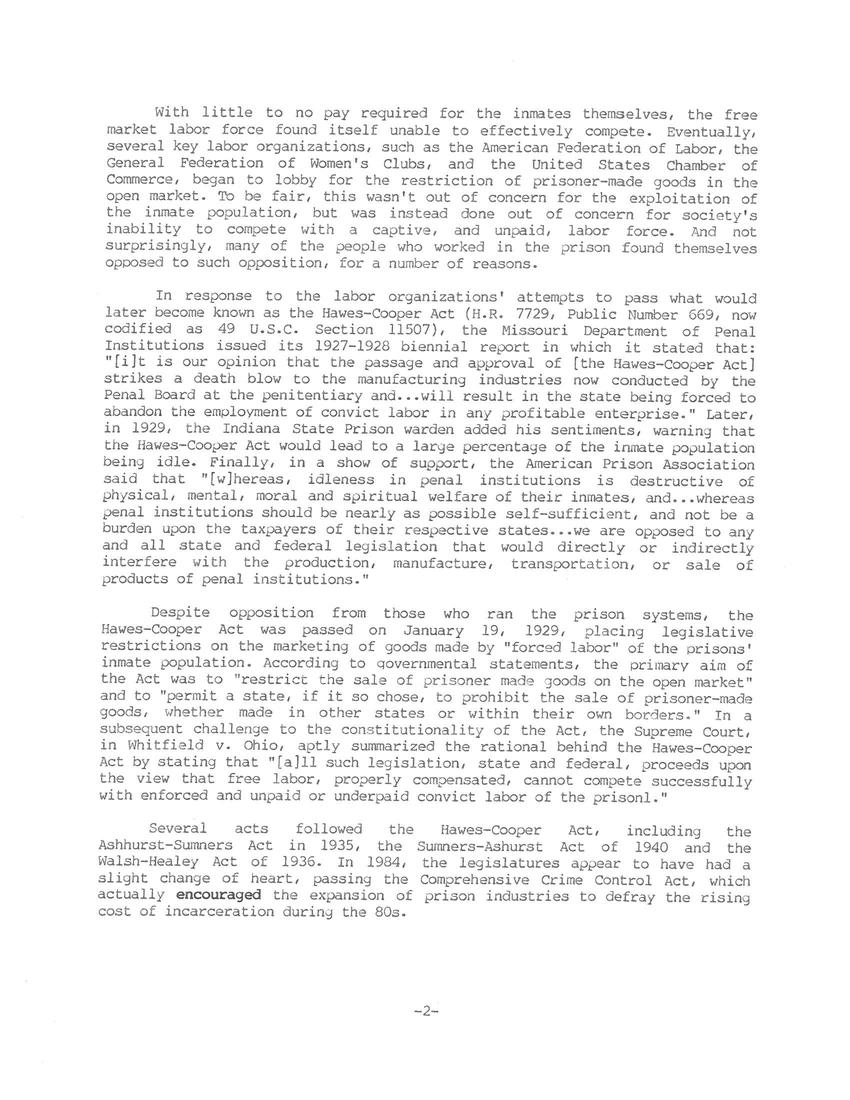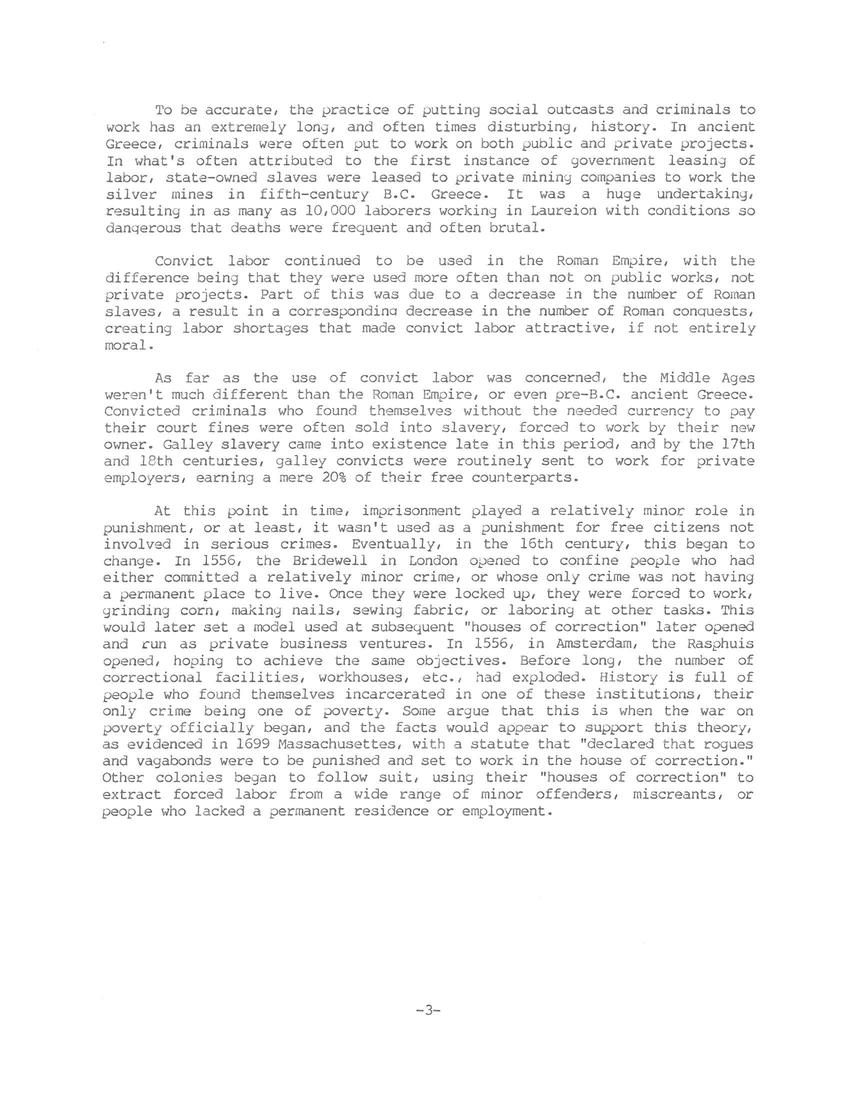Transcription
THE EVOLUTION OF THE PRISON SYSTEM
By Shawn L. Perrot
Saturday
June 1, 2013
Society has long turned to their inmate ranks for an inexhaustible source of cheap, or even free, labour. When America was first being settled, England began a practice known as "transporting," in which they shipped large numbers of convicts to the English colonies to work as indentured servants, or to work in prison labour camps, a practice that was also used to settle Australia. Transportation not only solved the problem of calming a savage and hostile land, it also dealt with England's surplus prison population. While England's penal methods would heavily influence the Colonial United States, the U.S. would gradually develop its own, distinct penal philosophy.
Immediately preceding, and during the Industrial Revolution, three separate, yet interrelated factors led to a decision to use inmates to perform labour in the United States. In 1789, Pennsylvania passed a law setting aside a section of the Walnut Street Jail specifically for the purpose of forcing convicted felons to engage in hard labour. This led to combining ideas about "reforming" convicts through religious salvation with "hard labour", and would dramatically change the American prison philosophy and subsequent development. Some time later, the Newgate prison and the Auburn prison system were developed on the Walnut Street model, a practice that would eventually be adopted by numerous prisons throughout the United States, over and over again.
The second thing to happen, and related to the first, was a change in the beliefs of prison administrators around the turn of the century, changes in belief that helped cultivate the notion that prisoners should be forced to work for their spiritual and physical livelihoods. Previously before this, solitary confinement and strictly imposed silence had been the preferred disciplinary strategy of administrators, but increasing costs of prison operations led administrators to examine potential ways in which prisons could become "self-sufficient" as well as "reformative". Gradually, hard labour and prayers became the norm of disciplinary programmes for early American prison administrators.
The third things, also related to the previous two factors, was the fact that the industrial revolution itself was generating broad and sweeping changes across both American and European societies. These industry growths across several sectors of the economy prompted plenty of unique opportunities for an enterprising capitalist to profit off of the labours of the prison population. For example, with the development of the sewing machine came improved methods for more efficient production in the garment industry; advanced technology brought along with it improved methods for manufacturing items moulded from iron in large prison sweat shops; and the discovery of oil, combined with the unique ability of inmates to cheaply produce things made from oil, translated into huge profits for those turning to the inmate population for cheap, or even free, labour as each of these industries relied on simple concepts of the division of labour and assembly-line production, both of which were very well suited to prisons and the people within them.
With little to no pay required for the inmates themselves, the free market labour force found itself unable to effectively compete. Eventually, several key labour organisations, such as the American Federation of Labour, the General Federation of Women's Clubs, and the United States Chamber of Commerce, began to lobby for the restriction of prisoner-made goods in the open market. To be fair, this wasn't out of concern for the exploitation of the inmate population, but was instead done out of concern for society's inability to compete with a captive, and unpaid, labour force. And not surprisingly, many of the people who worked in the prison found themselves opposed to such opposition, for a number of reasons.
In response to the labour organisations' attempts to pass what would later become know as the Hawes-Cooper Act (H.R. 7729, Public Number 669, now codified as 49 U.S.C. Section 11507), the Missouri Department of Penal Institutions issued its 1927-1928 biennial report in which it states that "[i]t is our opinion that the passage and approval of [the Hawes-Cooper Act] strikes a death blow to manufacturing industries now conducted by the Penal Board at the penitentiary and...will result in the state being forced to abandon the employment of convict labour in any profitable enterprise." Later, in 1929, the Indiana State Prison warden added his sentiments, warning that the Hawes-Cooper Act would lead to a large percentage of the inmate population being idle. Finally, in a show of support, the American Prison Association said that "[w]hereas, idleness in penal institutions is destructive of physical, mental, moral and spiritual welfare of their inmates, and... whereas penal institutions should be nearly as possible self-sufficient, and not be a burden upon the taxpayers of their respective states... we are opposed to any and all state and federal legislation that would directly or indirectly interfere with the production, manufacture, transportation, or sale of products of penal institutions."
Despite opposition from those who ran the prison systems, the Hawes-Cooper Act was passed on January 19, 1929, placing legislative restrictions on the marketing of goods made by "forced labour" of the prisons' inmate population. According to governmental statements, the primary aim of the Act was to "restrict the sale of prisoner made goods on the open market" and to "permit a state, if it so chose, to prohibit the sale of prisoner-made goods, whether made in other states or within their own borders." In a subsequent challenge to the constitutionality of the Act, the Supreme Court, in Whitfield v. Ohio, aptly summarised the rationale behind the Hawes-Cooper Act by stating that "[a]ll such legislation, state and federal, proceeds upon the view that free labour, properly compensated, cannot compete successfully with enforced and unpaid or underpaid convict labour of the prison."
Several acts followed the Hawes-Cooper Act, including the Ashurst-Sumners Act in 1935, the Sumners-Ashurst Act of 1940 and the Walsh-Healey Act of 1936. In 1984, the legislatures appear to have had a slight change of heart, passing the Comprehensive Crime Control Act, which actually encouraged the expansion of prison industries to defray the rising cost of incarceration during the 80s.
To be accurate, the practice of putting social outcasts and criminals to work has an extremely long, and often times disturbing, history. In ancient Greece, criminals were often put to work on both public and private projects. In what's often attributed to the first instance of government leasing of labor, state-owned slaves were leased to private mining companies to work the silver mines in fifth-century B.C. Greece. It was a huge undertaking, resulting in as many as 10,000 laborers working in Laureion with conditions so dangerous that deaths were frequent and often brutal.
Convict labor continued to be used in the Roman Empire, with the difference being that they were used more often than not on public works, not private projects. Part of this was due to a decrease in the number of Roman slaves, a result in a corresponding decrease in the number of Roman conquests, creating labor shortages that made convict labor attractive, if not entirely moral.
As far as the use of convict labor was concerned, the Middle Ages weren't much different than the Roman Empire, or even pre-B.C. ancient Greece. Convicted criminals who found themselves without the needed currency to pay their court fines were often sold into slavery, forced to work by their new owner. Galley slavery came into existence late in this period, and by the 17th and 18th centuries, galley convicts were routinely sent to work for private employers, earning a mere 20% of their free counterparts.
At this point in time, imprisonment played a relatively minor role in punishment, or at least, it wasn't used as a punishment for free citizens not involved in serious crimes. Eventually, in the 16th century, this began to change. In 1556, the Bridewell in London opened to confine people who had either committed a relatively minor crime, or whose only crime was not having a permanent place to live. Once they were locked up, they were forced to work, grinding corn, making nails, sewing fabric, or laboring at other tasks. This would later set a model used at subsequent "houses of correction" later opened and run as private business ventures. In 1556, in Amsterdam, the Rasphuis opened, hoping to achieve the same objectives. Before long, the number of correctional facilities, workhouses, etc., had exploded. History is full of people who found themselves incarcerated in one of these institutions, their only crime being one of poverty. Some argue that this is when the war on poverty officially began, and the facts would appear to support this theory, as evidenced in 1699 Massachusetts, with a statute that "declared that rogues and vagabonds were to be punished and set to work in the house of correction". Other colonies began to follow suit, using their "houses of correction" to extract forced labor from a wide range of minor offenders, miscreants, or people who lacked a permanent residence or employment.
These "houses of correction" would later form the basis for what became known as the "piece-price contract" and the "lease system". With the piece-price contract, a private contractor paid the prison, not the inmate, for each finished piece manufactured by the inmate. The contractor would pay for the raw materials, but the inmates would remain in the prisons, working under the supervision of the prison employees. In this way, the contractor's involvement, and therefore risk, was minimal, as was the amount of money they'd have to pay to the prisons compared to what they'd have to pay to a citizen who wasn't incarcerated.
The lease system, on the other hand, differed dramatically. For starters, the inmates didn't necessarily have to stay in the prison to complete their work, but could be taken to a worksite outside. Daily care of the inmates, including feeding, clothing, housing and discipline, was provided by the private entrepreneur, with the state receiving a flat fee that was typically based on the number of inmates handled over a pre-determined period of time. In both of these instances though, the piece-price contract and the lease system, it was the prison, not the inmates, who benefited, as it was the prison system, not the inmates who received money for the work performed by the inmate population, work the inmates often had little to no opportunity to avoid performing.
The first recorded leasing system in America was crafted in Kentucky in 1865 by a merchant named Joel Scott. He offered to pay the state a sum of $1,000 per year for the labor of the inmates confined in the Frankfort prison, an offer that was rewarded with a 5-year lease, allowing him to take complete control of the prison. During the term of the lease, he added new cells, a dining room, a chapel and even of course, new factories. Both Scott and his successor, T.S. Theobold, were able to turn a handsome profit using inmate labor. Of course, it should be pointed out that while the Frankfort was the first "pure" leasing arrangement, this was by no means the first time a private entrepreneur entered into an arrangement with a prison system to profit from inmate labor.
Other states began to copy the plan used in Kentucky. The main reason, pure and simple, was all about money. Legislators, and society in general, found themselves concerned with how to pay for the building and maintenance of prisons, not to mention the costs associated with incarceration. As a nation used to inexpensive methods of punishment, such as flogging, execution, banishment, etc., they now had to pay for detention, and everything it implied (food, shelter, security, medical, etc.), a cost that was borne by the very people the criminal had just victimized. As a result, the wardens who ran the prisons were asked to come up with alternatives to decrease the economic burden of incarceration, making the piece-price contracts and leasing system look even more attractive. This would also explain why, when the labor organizations began to lobby for changes in the law, resulting in the Hawes-Cooper Act of 1929, there was so much opposition from those in charge of the prison system. Not only did it mean that the state would have to fund the stay of anyone incarcerated, but it also meant that those who ran the prisons would see a decrease in whatever payments they were personally receiving from private entrepreneurs.
Just because a lessee arrangement helped pay for the operation of the prison didn't always make it a good thing. The lessee's main interest was in maximizing his profit from the management of the institution. As a result, maintenance costs, feeding, medical care, etc., were all kept to a bare minimum. Even the guards hired to work in the prison were paid meager wages as compared to their state-paid counterparts. Prisoners were often worked from dawn to dusk, force obtained by the whip of the ever-present overseer.
Eventually, the increasing number of complaints about the conditions endured by the convict population led to increasing opposition about the lease system. This proved to be an uphill battle, as states didn't want to absorb the cost associated with running their own prison systems. Add to this the fact that many of the state inspectors were also wardens for private companies, and special interests began to become intertwined with the states' interests. Convict labor became a financial windfall for the politicians who profited from the lease system, causing them to resist its abolition.
In the end, temporarily at least, what brought an end to the lease system was not society's wholesale revulsion at the inhumane practices prevalent in the lease system, but the economic objections voiced by both laborers and businesses who argued that they were at a competitive disadvantage. Companies who utilized forced convict labor had an inexhaustible supply of cheap, or sometimes free, labor to draw from, while those who wouldn't (or more likely, couldn't) get their foot in the door had to pay a minimum wage to people in the outside world to do the same work. By the turn of the 19th century, a number of states had eliminated leasing, and by the turn of the 20th, the leasing system was essentially finished, as it had then existed. Convict labor was still used, but now it was under direct control of the state and/or public account systems. These systems were supposed to remove the profit motives that had resulted in so many of the abuses suffered by the convicts subjected to the leasing system. This was not, however, the end of exploiting inmate labor for profit.
Today, California, like many other states in America, seems to have returned to exploiting inmate labor. While not exactly a lease system, there are a number of factories located within the California prisons, factories which manufacture everything from boots to socks, t-shirts to prison uniforms, furniture to license plate stickers, all of which are then sold by the private company to the state for a profit, and some of which are then sold by the state to the citizens of that state of California for an even healthier profit (as in the case of license plate stickers). As with both the piece-price contract and the lease system, the convict population is forced to work, and to be productive, or face sanctions for failing to do so, and as with their previous counterparts, today's convict population receives very little in the way of financial compensation. Pay is measured in mere pennies per hour, our of which the prison deducts 50% to apply towards an inmate's restitution, with another 5% going towards a mandatory "administrative fee". Possibly because of their extremely meager pay, inmates don't pay taxes, which means that they also don't contribute to social security, retirement savings, etc., nor does it appear that the private companies make such contributions on their behalf. Instead, inmates labor for years, decades even, and when they're released back into society, they're often too old to compete with others in the labor market, and they can't even apply for governmental assistance due to the nature of their convictions. They have no savings, social security, retirement, etc. to rely on while they try to get on their feet. Although this is certainly no excuse, not surprisingly, many commit another crime, returning to prison where they'll at least have shelter during inclement weather, even if the roof does leak, where they're exposed to asbestos, cruel and unusual conditions and even a lack of medical care.
Many people aren't sure what the future of the prison system holds, especially in light of continued and ever-increasing prison privatization. However, one thing remains clear: as long as there's a way to profit from the people who find themselves behind bars, there's no incentive for helping them to get out and stay out, but get out, most of us will, which is why we need to keep in mind this one simple concept, voiced by Dr. Mary Belle Harris, the first superintendent of Alderson Prison: "[w]e must remember always that the 'doors of prisons swing both ways'; that most of their tenants are coming back to the community to sit beside us in the street-cars, and beside the children of our families at the movies, with no bars between and no wall around them. Unless we have built within them a wall of self-respect, moral integrity, and a desire to be an asset to the community instead of a menace, we have not protected society - which is ourselves - from the criminal. Whether he deserves it or not, we owe it to ourselves as citizens of an enlightened country to proceed more intelligently in our treatment of the prisoner." For this reason alone, prisoners need to stop being viewed as less than human, people with little to no rights, and people who aren't given an adequate opportunity to prepare for their future. Instead, convicts need to be allowed to use their time constructively, to be paid a fair wage for their work, which also means all the responsibilities that come along with it, i.e., paying taxes, putting money into retirement, social security, deductions for "room and board", etc. Also, the powers that be need to stop interfering with an inmate's desire to rehabilitate himself, as they so frequently do in the California Department of Corrections and "Rehabilitation" (CDCR), and instead work with the inmate to allow him to make the most out of his time spent incarcerated. Unfortunately, until society stands up and demands otherwise, history will continue to repeat itself, and rather than treating prisoners like humans, they will instead continue to be treated as slaves, something that was supposed to have been eliminated long ago.
I was unable to address many of the issues so prevalent in today's prison industry complex, partly because I didn't want to lose the attention of my readers, and partly because I could literally go on for hours about the things I've seen. If there's something you'd like information on, something you'd like to hear my opinion on, please don't hesitate to contact me at the address listed below. As always, I sincerely appreciate the fact that you've taken the time to read my blog, and I'm looking forward to whatever response you may happen to have, positive or critical.
Shawn L. Perrot CDCR# V-42461
CMC-East Cell# 6326
P.O. Box 8101
San Luis Obispo, CA 93409-8101
Other posts by this author
|
2020 aug 12

|
2020 aug 12

|
2020 may 30

|
2020 may 30

|
2020 may 30

|
2020 may 24

|
More... |








Replies